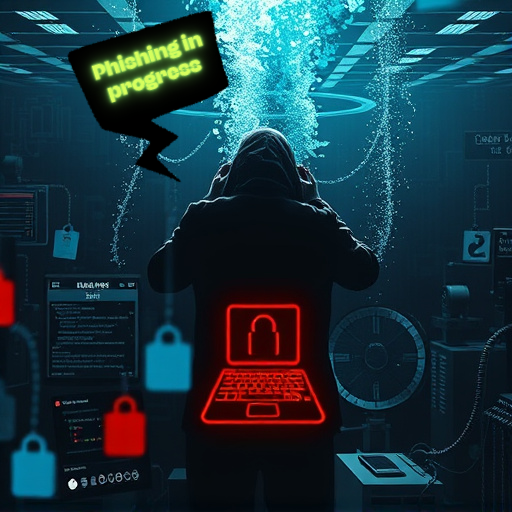- Posted on
- • Cyber Attacks
Deep Dive into the Deceptive World of Cybercrime
- Author
-
-

- User
- Varinder
- Posts by this author
- Posts by this author
-
Phishing remains one of the most pervasive and effective cyber threats, tricking individuals and organizations into surrendering sensitive information or downloading malware. To truly understand its danger, we need to dissect the anatomy of a phishing attack.

1. Setting the Trap: The Art of the Lure
Phishing attacks hinge on deception, employing carefully crafted bait to pique a victim's curiosity or trigger a sense of urgency. This often manifests as:
Emails: Masquerading as legitimate communications from trusted sources like banks (e.g., "Your account has been compromised!"), social media platforms (e.g., "Suspicious login attempt detected!"), or government agencies (e.g., "Important tax refund information"). Text Messages (Smishing): Exploiting the immediacy of SMS to deliver fake alerts, enticing offers, or urgent requests for information (e.g., "You've won a prize! Click here to claim it!"). Social Media Messages: Leveraging social connections to spread malicious links or requests, often impersonating friends or colleagues (e.g., "Check out this funny video!"). Websites (Pharming): Creating counterfeit websites that mimic legitimate ones, aiming to capture login credentials (e.g., a fake bank login page).
2. Delivering the Payload: The Hook
The hook is the mechanism that delivers the malicious payload, often through:
Malicious Links: Leading victims to fraudulent websites designed to harvest credentials or install malware. Attachments: Containing malware disguised as innocuous documents or files, such as invoices, resumes, or images. Social Engineering: Employing psychological manipulation to gain trust and elicit cooperation, often by creating a false sense of authority or urgency.
3. The Endgame: Reeling in the Victim
Once the victim takes the bait and interacts with the hook, the attacker achieves their objective:
Credential Theft: Capturing usernames, passwords, credit card details, and other sensitive information.
Malware Infection: Installing malware like ransomware, spyware, or Trojans to steal data, control systems, or launch further attacks.
Financial Fraud: Deceiving victims into transferring money, making fraudulent purchases, or revealing financial information.
Types of Phishing Attacks
Spear Phishing: Highly targeted attacks aimed at specific individuals or organizations, often using personalized information to increase credibility. Whaling: Targeting high-profile individuals like CEOs, executives, or celebrities, often involving larger financial gains or access to sensitive corporate data. Vishing: Using phone calls to trick victims into revealing information, often impersonating bank officials, tech support, or government agencies. Angler Phishing: Exploiting social media platforms by impersonating customer service representatives to gather information or resolve fake issues. Phishing Statistics: A Sobering Reality
Verizon's 2024 Data Breach Investigations Report: Phishing was present in 36% of breaches analyzed, highlighting its continued prevalence. Anti-Phishing Working Group (APWG): In Q2 2024, APWG reported a record 1,187,472 phishing attacks, with SaaS and webmail providers increasingly targeted. PhishTank: PhishTank, a collaborative phishing website reporting platform, receives thousands of daily submissions, indicating the sheer volume of phishing attempts. Microsoft: Microsoft reported blocking over 13 billion malicious and suspicious emails in 2024, with a significant portion linked to phishing attacks. Real-World Examples: High-Profile Attacks
The "RSA SecurID" Breach (2011): Attackers used a spear-phishing email with the subject line "2011 Recruitment Plan" to infiltrate RSA's network, ultimately compromising their SecurID two-factor authentication tokens. (Source: Krebs on Security]([invalid URL removed])) The "Colonial Pipeline" Ransomware Attack (2021): While the initial attack vector remains unclear, reports suggest a compromised password, potentially obtained through phishing, may have played a role in this crippling ransomware attack that disrupted fuel supplies across the US East Coast. (Source: [Bloomberg [invalid URL removed]) Best Measures Against Phishing Attacks
Awareness and Education: Regularly train employees and individuals to recognize phishing red flags (suspicious sender addresses, grammar errors, urgent requests, etc.) and avoid clicking on suspicious links or attachments. Email Filtering and Security: Implement robust email security solutions with spam filters, anti-malware scanning, and spoofing protection. Multi-Factor Authentication (MFA): Enforce MFA on all accounts, adding an extra layer of security to prevent unauthorized access even if credentials are compromised. Anti-Phishing Software: Deploy anti-phishing software to detect and block phishing websites and emails. Regular Security Updates: Keep software, operating systems, and browsers updated to patch vulnerabilities that attackers exploit. Incident Response Plan: Develop a comprehensive incident response plan to handle phishing attacks, contain damage, and recover quickly. Website Filtering: Use web filtering tools to block access to known phishing websites. Password Managers: Encourage the use of password managers to generate and store strong, unique passwords, reducing the impact of credential theft. By understanding the anatomy of phishing attacks, staying informed about the latest tactics, and implementing effective countermeasures, individuals and organizations can significantly reduce their risk of falling victim to these deceptive threats.